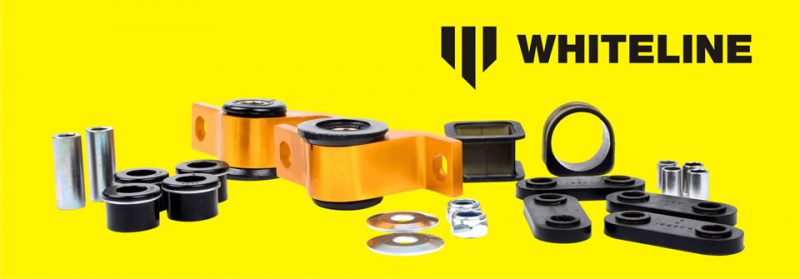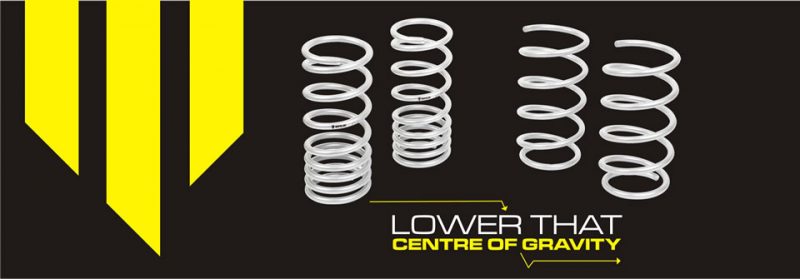WHITELINE
Whiteline boasts a worldwide reputation as a leading manufacturer of replacement, enhancement and performance suspension components that deliver significant gains in vehicle balance, steering precision, grip levels and outright driving performance.

Activate More Grip.
Whiteline’s boasts a worldwide reputation as a leading manufacturer of replacement, enhancement and performance suspension components that deliver significant gains in vehicle balance, steering precision, grip levels and outright driving performance. Consisting of adjustable sway bars (also known as Stabilizer Bars or Anti Roll Bars), chassis bracing, alignment products and chassis control bushing kits, Whiteline products provide automotive workshops, tuners, enthusiasts and racers with innovative solutions to suspension and handling problems while delivering proven performance & problem solving outcomes for many of the worlds vehicle platforms.
Whiteline products are developed up by a qualified and willing engineering group of dedicated enthusiasts who are trained in the company’s products and philosophy. Using a range of sophisticated testing and data logging tools, we rely on comprehensive testing to maximise the product benefits and ensure that they work as a complete package tuned to give you the best handling outcome. Whiteline has the products and practical experience to maximise the potential of your vehicle whether it be a daily driver, street performance or motorsport vehicle and guarantees a quality, tested and tuned outcome using Whiteline products.
What makes Whiteline different?
Unique Products - Whiteline is the only brand globally to market a full range of undercar chassis and suspension components that complements your spring and damper/ shock absorber set up. Simply, it is a tuned system and not a collective of various brands.
Activate more grip - Engineered to activate more grip for improved handling and outright performance, Whiteline products are rigorously tested on the track to provide unrivalled street performance!
No compromise - Advanced designs, material technologies and extensive testing ensures minimal effects on ride quality and maximum effects on handling precision.
Solutions - From automotive repair workshops to race teams, Whiteline offers proven product solutions to suspension and handling problems for many of the worlds vehicle platforms.
Our version of Stability Control!!!!
Whiteline’s range of products includes:
Adjustable Sway Bars, Stabilizer Bars or Anti Roll Bars - The best “value for money” handling improvement you can make, with adjustable kits also available.
Chassis Control Bushings – Our “Engineered Elastomer Bushings” feature the quality ride of rubber at lower speeds and at higher speeds react when under cornering, accelerating and braking loads, for CHASSIS CONTROL and improved handling.
Camber & Toe Kits - Proper camber adjustment is essential for tyre wear and performance where proper toe adjustment can transform turn-in from “passive” to “alive”.
Caster Kits - There’s almost no such thing as too much positive caster for performance driving. Click here
Anti Lift Kits – Ensuring more compliant suspension that delivers improved front end grip with added caster gains.
Roll Center & Bump Steer Correction Kits - Designed to reset the front roll-center geometry and bump steer settings on performance and lowered vehicles.
Strut and Chassis Bracing – In regards to performance you can never have too much chassis stiffness.
Whiteline Performance Springs

Whiteline performance springs deliver improved vehicle performance whilst maintaining safety and ride quality characteristics. By lowering the vehicles center of gravity, the unique and progressive rate coil design not only improves performance but enhances overall appearance. Developed and manufactured in Europe from the highest quality materials, coating and to the finest tolerances guaranteeing exact fitment.
Whiteline performance springs are engineered for optimal balance with OEM and aftermarket shocks. For total grip activation match with Whiteline Sway Bars and Essential kits for Unrivalled handling and optimal vehicle performance.
- Progressive rate coil for enhanced performance.
- Engineered for superior fit and performance with OEM shocks.
- Manufactured in Europe from the highest quality material.
- Signature silver powder coating.
- Backed by a Limited Lifetime Warranty.
Match with Whiteline Sway Bars and Essential kits for optimal performance.
ALIGNMENT SETTINGS - WHAT ARE THE BEST ONES?
The simple answer is that there is no such thing!
I know we have probably given more information here than most people wanted, but even this only scratches the surface of the available information and variables that need to be considered when contemplating optimum wheel alignment settings.
The most important thing and something we can not stress enough is the fact that alignment settings are NOT an “absolute truth” that can be held up as an undisputed rule. It is a dynamic process with the “correct value” varying from driver to driver, car to car not to mention the driving environment.
DYNAMIC & STATIC – WHAT ARE YOU TALKING ABOUT?
Typically used when discussing wheel alignment and geometry. By this, Whiteline are referring to the difference in alignment angles between a stationary and a moving vehicle. That is, the same vehicle will typically have different caster, camber and toe readings when it is moving compared to when the alignment was done in static form in the workshop.
In an ideal world, all wheel alignments would be done on a dynamic wheel aligner but these are expensive and quite rare. This concept is very important, as the only suspension angles that really matter are those present while the vehicle is moving (dynamic). What is done to the vehicle’s alignment while the vehicle is stationary, (static) is a process of trying to predict the levels of change while the vehicle is moving and setting the angles according to these predictions.
Whiteline puts a great deal of emphasis on the dynamic geometry so rigorous road testing is essential to ensure that the predictions are valid.
CAMBER – WHAT IS IT?
Camber is the inclination of the wheel from the vertical when viewed from the front. When the top of the wheel leans out you have positive camber, lean in equal’s negative camber.
Static negative camber is used to compensate for body roll, body distortion and tyre roll under when cornering. Stiffer bodies and tyre sidewalls are in and unnecessary suspension compliance is out. Therefore the previous requirements for large amounts of static negative camber are disappearing. Whiteline strut braces are good for maintaining camber angles under cornering loads as they further minimise body flex.
Its important to highlight the fact that camber settings are ultimately a personal thing. That is, Whiteline can provide an indicative range to start from but the final number will depend on your driving style, average driving conditions, tyre size and many other things. You need to start with a relevant number, then monitor tyre wear and compensate if necessary.
Whiteline have a range of camber adjusting products available to achieve the optimum settings.
CASTER – WHAT IS IT?
Caster is the backward or forward tilt of the steering axis. Vehicle manufacturers are aware of the advantages of caster and as each new model is released the amount of caster specified increases.
Why, because the disadvantages of high levels of castor are being overcome. Rack and pinion steering means less play, lower Ackerman levels, smaller scrub radius (zero is now very common), better and lower profile radial tyres means less sidewall deflection and higher tolerance to greater slip angles. But the greatest obstacle, that of heavy steering effort, has all but disappeared with the universal acceptance of power steering.
High levels of positive caster equate to dynamic negative camber on turn when you need it most. Whiteline continues to put heavy emphasis on additional positive caster when designing new suspension packages.
Toe
If you were able to view the front tyres of a vehicle from above the car, you would expect them to look exactly parallel to each other. In fact, they rarely are. The difference in distance between the front edge of the tyres and the rear edge is called toe. Toe describes how close to parallel the two tyres are, and whether they are toed-in (closer at the front of the tyre) or toed-out (closer at the rear of the tyre). The goal of toe is to provide proper tyre wear through various driving conditions. The amount of toe your suspension is set to varies by the drive layout of your vehicle, driving preference, and car’s handling characteristics.
On a rear-wheel-driven car, acceleration forces on the tyre tend t o push the front tyres back slightly in the wheel well. Static toe-in will result in a zero-toe situation at speed. For a front-wheel-driven vehicle, the front wheels will pull themselves forward in the wheel wells under acceleration. This happens because as the (driven) front wheels claw for traction, they pull themselves forward, dragging the rest of the car along. For this situation, static toe-out will result in a zero-toe condition at speed. Assuming that the rest of the suspension is correctly aligned and maintained, and the tyres properly inflated, toe-in will result in additional understeer for the car. In a corner the inside front tyre will turn at less of an angle than the outside tyre. Additionally, excessive toe-in will result in premature tyre wear through feathering, and increased fuel consumption. Conversely, toe-out will result in additional oversteer for the vehicle. This occurs as the inside front tyre turns at a greater angle than the outside tyre. Thus, in a corner, the inside tyre is trying to turn even more than the heavily-loaded outside tyre. Excessive toe-out will also result in premature tyre wear due to feathering, and increased fuel consumption.
“Anti” Geometry
“Anti” features in suspension systems are a characteristic that can be used to influence the stiffness of the front or rear suspension under traction forces(under braking or accelerating). The individual terms are relatively straightforward and self-explanatory with the “anti” reducing or totally restricting the characteristic (lifting or diving). In the front suspension there may be levels of anti-dive during braking and anti-lift during accelerating (assuming traction to the front wheels is present), similarly in the rear there could be anti lift during braking and anti-squat during acceleration.
It should also be noted that these characteristic can also be reversed into a “pro” characteristic (as in pro-lift at the front under braking). Anti features can only be implemented under the influence of the braking or accelerating forces at the wheels, for example a rear wheel drive vehicle cannot have an anti-lift characteristic in the front (as there is no drive to the front wheels).
With the ALK fitted to the Subaru WRX, a softer suspension will be present during braking and accelerating. This will help traction, as the wheel will be able to track the ground more precisely. Also in terms of balance the front end will have a proportionally lower roll resistance during traction or braking, aiding in reducing the power understeer effect that is present in these cars.
Swaybars, Stabiliser Bars, Anti-Roll Bars
As the name suggests their objective is to reduce sway, or body roll, and stabilise a vehicle under lateral (cornering) forces. Formula 1 cars still use sway bars along side the shocks and springs as it is the ONLY suspension component principally designed to control body roll. Unfortunately, many aftermarket spring manufacturers still design their lowered springs too hard, trying to control body roll when it’s the sway bars job.
The fitting of bigger Whiteline Sway bars is still the best dollar for dollar handling improvement you can make.
Why? First, while car manufacturers appreciate the role the sway bar plays in vehicle control, safety and comfort, their standard bars, like the vehicles they are fitted to, are built to a compromise of price, performance and comfort. Secondly, handling and suspension design is an evolutionary process with constant changes.
Whiteline Sway bars dramatically improve the grip, handling and performance of your vehicle. Cornering loads are spread more evenly across the tyres delivering more grip and frankly, that’s what it’s all about. You also get improved tyre wear as your tyres stay flatter and more upright. Comfort improves because your car sits flatter through bends meaning less movement inside the vehicle.

